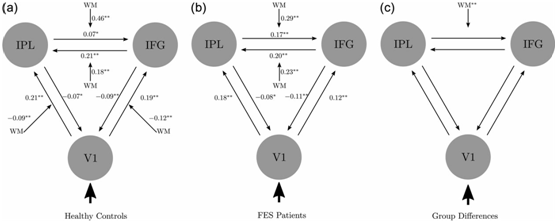
Working memory (WM) is a memory system that works astemporary storage and process of information for guiding future behavior. WM impairment is a common cognitive deficit in schizophrenia, and is viewed as an important aspect of schizophrenic thought disorder, potentially underlying several of the cognitive impairments observed in schizophrenia.
Therefore, the neural basis of working memory impairment in schizophrenia has been an active and important research topic. Functional integration of lateral prefrontal cortexand posterior parietal cortex appears crucial for WM performance. However, the neural mechanisms behind this cognitive impairment remain unclear.
In a recent study conducted by Dr. ZHOU Yuan and her collaborators, Dr. Kristoffer H. Madsen from Technical University of Denmark, Prof. Karl J. Friston from University College London, and Prof. LIU Zhening from Mental Health Institute of the Second Xiangya Hospital, Central South University, addressed this issue by applying dynamic causal modeling (DCM) on a WM dataset.
DCM enables estimation of effective connectivity among ensembles of neurons, as well as experimentally induced modulations of such connectivity, making it a powerful tool for investigating functional integration between regions.
This study recruited a cohort of FES patients, whose working memory performance during a verbal n-back task was not significantly reduced compared with the normal controls.
This characteristic in the sample makes it possible to discount effects due to task performance differences, a common confouder in previous studies.
Dynamic causal modeling of the coupling between regions (left inferior frontal gyrus (IFG), left inferior parietal lobe (IPL), and primary visual area (V1)) identified in a psychophysiological interaction (PPI) analysis was performed to characterize effective connectivity during the n-back task.
The PPI analysis revealed that the connectivity between the left IFG and left IPL was modulated by WM and that this modulation was reduced in FES patients. The subsequent DCM analysis confirmed this modulation by WM and found evidence that FES patients had reduced forward connectivity from IPL to IFG.
These results provide further evidence for impaired WM modulation of frontoparietal connectivity in schizophrenia and indicate relative failure of the schizophrenic brain to contextualize its connectivity. Such deficits are present at an early phase of schizophrenia, even with intact WM performance.

(a) Parameter estimates of DCM model in healthy controls. (b) Parameter estimates of DCM model in FES patients. (c) Between-group differences. (Image by IP)
This study has been published in Cerebral Cortex entitled "Working Memory Modulation of Frontoparietal Network Connectivity in First-Episode Schizophrenia.
The study was supported by grants from the National Natural Science Foundation of China, Youth Innovation Promotion Association of the Chinese Academy of Sciences, China Scholarship Council funding, and the National Basic Research Program of China.

86-10-68597521 (day)
86-10-68597289 (night)

52 Sanlihe Rd., Xicheng District,
Beijing, China (100864)

